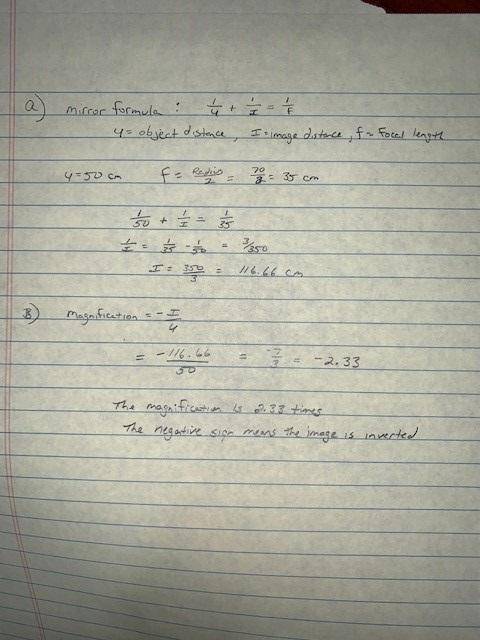
Physics, 16.10.2019 09:30 tyijiapostell
An object is placed 50 cm from a concave mirror of radius 70 cm. (a)what is the distance of the image from the mirror? (b) what is the lateral magnification of the image? show your work and provide units of measure for each answer.

Answers: 3
Another question on Physics

Physics, 22.06.2019 20:00
An element becomes a positively charged ion when itloses protons.loses electrons.gains electrons.gains neutrons.
Answers: 2

Physics, 22.06.2019 23:30
A6.0-kilogram cart initially traveling at 4.0 meters per second east accelerates uniformly at 0.50 meter per second squared east for 3.0 seconds. what is the speed of the cart at the end of this 3.0 second interval? (1) 1.5 m/s (3) 3.0 m/s (2) 5.5 m/s (4) 7.0 m/s
Answers: 1

Physics, 23.06.2019 00:10
An astronaut floating in space is trying to use her jetpack to get back to her space station, but she is being pulled away by a nearby planet, as shown in the image below. her jetpack provides a constant thrust of 310 n. if she angles her jetpack in such a way that it cancels out the vertical force due to the planet's gravity, what is her net horizontal force? thaud 487 o a. 54.8 n toward the space station o b. 212.9 n toward the space station o c. 185.2 n toward the space station o d 956 n toward the space station
Answers: 1

Physics, 23.06.2019 01:00
Learning goal: to understand newton's 1st law. newton's principia states this first law of motion: an object subject to no net force maintains its state of motion, either at rest or at constant speed in a right line. this law may be restated as follows: if the sum of all forces acting on an object is zero, then the acceleration of that object is zero. mathematically this is just a special case of the 2nd law of motion, f⃗ =ma⃗ , when f⃗ =0. when studying newtonian mechanics, it is best to remember the 1st law in two ways: if the net force (i.e., sum of all forces) acting on an object is zero, the object will keep moving with constant velocity (which may be zero). if an object is moving with constant velocity, that is, with zero acceleration, then the net force acting on that object must be zero. complete the following sentences to see if you can apply these ideas. part a if a car is moving to the left with constant velocity, one can conclude that
Answers: 1
You know the right answer?
An object is placed 50 cm from a concave mirror of radius 70 cm. (a)what is the distance of the imag...
Questions

Physics, 01.04.2020 22:03

Mathematics, 01.04.2020 22:03


Mathematics, 01.04.2020 22:03

Physics, 01.04.2020 22:03

Social Studies, 01.04.2020 22:03






French, 01.04.2020 22:04


Mathematics, 01.04.2020 22:04


English, 01.04.2020 22:04

Social Studies, 01.04.2020 22:04


Biology, 01.04.2020 22:05




